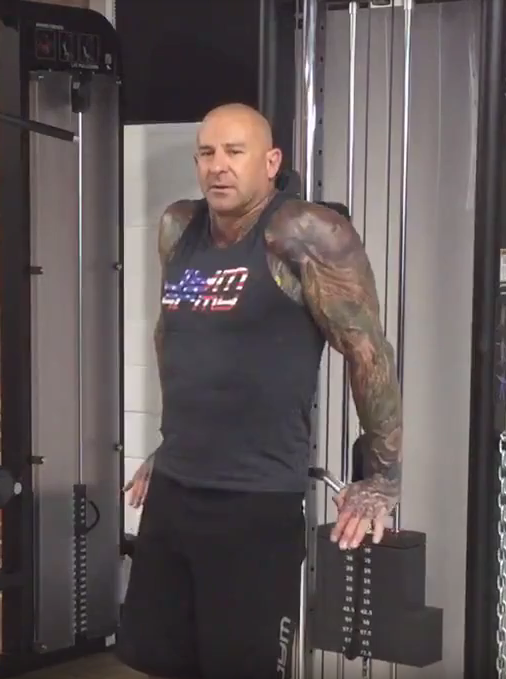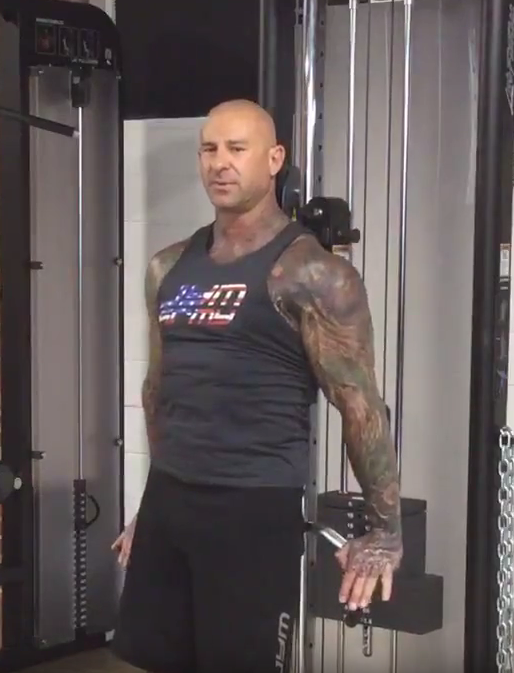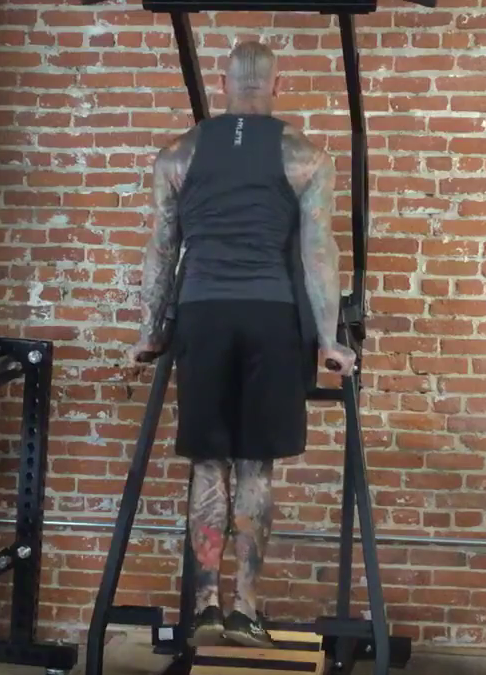Straight-Arm Pushdown Master Class
Target your lower traps for balanced shoulder development and reduced injury risk by pushing down as often as you shrug up.

Target your lower traps for balanced shoulder development and reduced injury risk by pushing down as often as you shrug up.

Note: The above video was recorded as a Facebook Live tutorial in conjunction with the Train With Jim Full-Body Shortcut to Size program.
Most people are concerned with building big upper traps, primarily through shrugging movements (barbell shrugs, dumbbell shrugs, etc.), but also with upright rows. When you focus only on the upper traps, though, you create a problem: an imbalance between the upper traps and lower traps.
That’s why I’m a big proponent of regularly incorporating exercises for the lower traps, like the straight-arm pushdown. That way, you have better balance between the upper and lower traps, and you reduce your risk of injury.
Most people are concerned with building big upper traps, primarily through shrugging movements (barbell shrugs, dumbbell shrugs, etc.), but also with upright rows. When you focus only on the upper traps, though, you create a problem: an imbalance between the upper traps and lower traps. That’s why I’m a big proponent of regularly incorporating exercises for the lower traps, like the straight-arm pushdown. That way, you have better balance between the upper and lower traps.
When people reference the “traps,” they’re usually talking about the upper traps. But there are actually three different trapezius muscles on the posterior side of the torso: the upper, middle, and lower traps. All three need to be sufficiently developed for optimal performance, movement patterns, and joint health. It all comes down to balance.
Strength imbalances anywhere in the body can cause problems. Before I get into traps, let’s discuss another more common example: the quadriceps and hamstrings. One of the reasons the hamstrings are so frequently pulled in runners is because the quadriceps tend to overpower the hamstrings. There are typically strength differences between the quads and hams. When it's a significant difference, it leaves one muscle group susceptible to injury (usually the hamstrings, but not always), and you also tend to get a lot of pain.
Back to the traps. When people who work in offices complain about shoulder and neck pain, its often due to an overpowering set of upper traps, which are being used all day to pull up the shoulders while you’re typing on the keyboard, using your computer’s mouse, and talking on the phone. As a result, the lower traps become weak compared to the upper traps, and it causes a lot of neck and shoulder pain.
For those who train in the gym, a similar imbalance can occur if you train the upper traps hard with different variations of shrugs but ignore lower trap-strengthening exercises. When doing shrugs, you’re lifting your shoulders upward (“elevation” of the shoulder girdle, to be technical), which is targeting those upper traps. The lower traps do the opposite: They pull the shoulder blades down (“depression” of the shoulder girdle).
Just as you isolate the upper traps with shrugs, so too should you isolate the lower traps with the opposite movement. And one of the best exercises for doing this is the cable straight-arm pushdown – the exact opposite movement of a cable shrug.
One of the easiest ways to do straight-arm pushdowns is on a cable crossover station where the pulleys are adjustable up and down the side columns. If the pulleys aren’t adjustable and you’re stuck using the high pulley setting, getting the bar down and in proper position behind your back can be really awkward, if not impossible. (Go to the 6:30 mark in the above video to see what I’m talking about.)
If you've got an adjustable pulley, you can set it up so that the bar is lower and you’re able to get in the proper position to start the exercise.
If you don’t have an adjustable pulley, however, there is one thing you can do: Use a length of chain to bring the bar down lower while still originating from the high pulley. (I demonstrate at around the 8:00 mark of the video.) You can buy some chain for pretty cheap at a hardware store, and many gyms have chains lying around for a variety of purposes.
If your cable pulley is fully adjustable, here's what the start position of each rep will look like:

When you're doing the straight-arm pushdown (or the straight-arm dip, for that matter), the whole concept is to NOT bend your arms. You don't want to lower the weight by bending your elbows. You want to keep your arms completely straight.
When you lower the weight without using your arms (ie, triceps), you’re using your lower traps to initiate the movement – your lower traps are pulling your shoulder blades down. That’s all that’s going on here; it’s a pretty subtle movement, but it’s an important one.
At the bottom of each rep, you really want to make sure to focus on squeezing your shoulder blades together and down; that's how you feel those lower traps and get a full contraction in them.

The straight-arm dip, which I demonstrate in the above video at around the 5:00 mark, is another great lower trap exercise. It’s essentially the bodyweight version of the straight-arm pushdown.
What you're doing here is lifting your body up with straight arms using your lower traps. Like the straight-arm pushdown, it’s a pretty small range of motion.

The issue with straight-arm dips, however, is that because it’s a bodyweight movement, it can be too heavy for some people. That’s what the straight-arm pushdown is for – to mimic the same movement as the straight-arm dip, but to allow for different resistances to be used depending on your individual strength level.
Straight-arm pushdowns can also be performed one arm a time using a stirrup or "D" handle attachment at the cable station. The technique is exactly the same with the one-arm version as with two arms.
To see a quick video demonstration of the one-arm version, check out the below TikTok video I did on the exercise. The one-arm version appears at the very end of it.
@dr_jimstoppani The straight-arm pushdown ##exercise works the lower ##traps and helps eliminate ##strength imbalances as well as ##neckpain and ##shoulderpain ##gymtips
♬ Swear By It - Clutch
So there you have it – two great options for hitting the lower traps to minimize injury risk and stay pain free. If you don't want to do it on the pulleys, go over to the dip station at your gym and do the movement with your body weight.
But the main reason I like the cable version is because in my programs I constantly change up the rep ranges. And if on straight-arm dips you’re not able to get more than, say, 8 or 10 reps with your bodyweight, you’ll have a hard time doing a workout that calls for 12-15 or 20+ reps per exercise.
Find this exercise on Day 3 (shoulders and traps focus workout) of all four weeks of my Full-Body Shortcut to Size program. For a great opposing-muscle-groups superset, pair straight-arm pushdowns with cable shrugs.
Related Articles